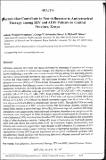| dc.description.abstract | Adherence concerns have been one reason expressed by opponents of antiretroviral therapy in developing countries or resource poor settings. The objective of the study was to determine factors contributing to non-adherence to Anti-retroviral therapy among HIV and AIDS patients. This was a Cross sectional, descriptive study carried out in Provincial General Hospital Nyeri, Karatina and Thika District Hospitals. The participants included 300 interviewees, 15 Key Informant Interviews (KIIs) and 3 Focus Group Discussions (FGDs) with 8 members each. In regards to the results, the Odds ratio was used to test for association between variables and level of significance. Results also showed that the prevalence of adherence to ART was 7 4%. Risk factors associated with non-adherence were: age (p<0.039 OR=l.287 95% CI 1.013-1.634), occupation (p<0.0001 OR=l.675 95% CI 1.449-1.937), food (p<0.002 OR=0.419 95% CI 0.242-0.726), level of education (p<0.023 OR=0.593 95% CI 0.378-0.930), and stigma (p<0.002 OR=2.456 95% CI 1.375-4.389). 23% of those who lacked community support were found to be suffering from stigma and did not adhere to Antiretroviral Therapy (ART). Through the FGDs the study revealed that co-treatment of HIV and other diseases like tuberculosis, diabetes, epilepsy and mental illness remains a major challenge. 66% of Key Informants reported pediatric ARV drugs formulations were inappropriate, unpalatable and inadequate, dependence on care givers and the laboratories were ill-equipped in terms of facilities, reagents and personnel. In conclusion, the level of adherence (74%) was sub optimal (less than 95% which is the acceptable) but comparable to that of other developing countries. Taking ARV drugs without eating any food made patients suffer from side effects thus making them avoid the medication. Stigma, discrimination, lack of family and community support were huge obstacles to ART adherence. Co-treatment of HIV and other infections remain a major challenge. Shortage of appropriate pediatric formulations, unpalatability of some ARV drugs and dependence on care givers contributed to pediatric ART non-adherence. Health facilities with functioning laboratory, adequate personnel and stock of ARV drugs enhanced ART adherence. | en_US |

